

Hal Finney interview
By Scott Stilphen
(2006)

As the story goes, APh Technology Consultants (located in Pasadena, CA) was hired by Mattel in 1976 to help design what became the Intellivision system; eventually they programmed the system's software, most of the development tools, and all of the first Intellivision, M Network, and Keyboard Component games. The team consisted of APh president Glenn Hightower, graphics artist Dave James (from the Mattel Design & Development Department, who worked with APh to define the Intellivisionís system graphics, including the familiar running-man animation), and programmers, who were graduates of the California Institute of Technology (CalTech). The name, APh, was derived from the Applied Physics courses offered at CalTech. One of those graduates was Hal Finney, who became one of the more prolific game designers there.
Q: You graduated from the California Institute of Technology with a BS in Engineering in 1979, correct? What was your first job after school?
Hal Finney: I was supposed to graduate in 1978 but I was short a few units. So I got hired full time at APh the summer of 1978 and just took the remaining classes at Caltech during that first year at APh, graduating in 1979. I continued working at APh until about 1986.
Q: When did you start at APh? Do you recall who you interviewed with?
Hal Finney: I think I was hired by Glenn Hightower, who was co-owner and the main manager at that time. I knew Dave Rolfe well, who was already working there, and he put in a good word for me.
Q: What was the first game you did?
Hal Finney: Actually I did not initially work on games at APh. My first year or so I was working on cash register software. APh had a number of consulting contracts with companies other than Mattel, although over the next few years the video game business became the largest effort of the firm.
My initial contribution to the games was creating the sound effects. The sound effect hardware on the Intellivision was primitive, but Dave Rolfe had created a sort of mini programming language to let you control it. The APh developers were busy just doing the game mechanics so I started fiddling with the sounds and was able to come up with some new effects. I had got a book on speech synthesis at the Caltech library and I tried to make the
chip talk, but it didn't really work that well. We ended up using it as the "Yer out!" sound in Major League Baseball.
It wasn't until a year or so later that I was free to do a game, and that was Space Battle.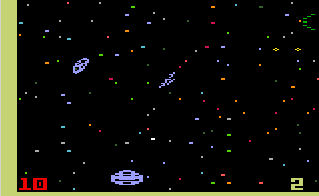
Q: Is it true Space Battle (and its M Network counterpart, Space Attack) was to be based on Battlestar Galactica? Was the problem that Mattel couldnít secure the rights for it?
Hal Finney: Yes, originally it was going to be based on BG, but I'm not sure of the specifics of why it had to be changed. Originally there was music based on the BG theme song, which got taken out. The ships were originally supposed to look like Cylon flying saucers, and that never changed. The graphics back then were crude enough that the resemblance wasn't strong enough to be a concern.
Q: What changes, if any, were made to the game after that happened (besides the name change)?
Hal Finney: I can't remember anything else that was changed. I think the decision to change the name was done pretty early on in the development process. It's not like we had a completed BG game and had to go back and change it. In practice the main hard part with those early games was making everything, graphics and program, fit in the 4-kilobyte cartridges.
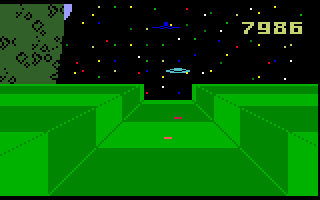
Q: Star Strike obviously derives some influence from Star Wars, but there was a coin-op game from Midway around that (Space Encounters) that is very similar. Were you influenced (or even aware) of the game at the time?
Hal Finney: No, I don't think so. I did most of Star Strike on my own. I was striving for the feeling of piloting a crippled spaceship on a desperate mission. As the game went on, your ship would tend to lose maneuverability as it got hit. However this didn't work out that well as it
tended to be more frustrating than fun. Plus, the Intellivision controllers weren't that reliable and so it felt like your controller was dying rather than that your ship was damaged.
The other thing I wanted was to have a really big explosion at the end, if you lost. You were blowing up a whole planet. So I set all the sound effects to be very quiet throughout the game. Usually we had the sounds at max volume in all the games, because the sound generator wasn't that powerful. But for this one I had the sounds way down so you'd have to turn your TV sound up to play it. Then at the end I used max volume if you blew up the station or the planet, so
it would shake the room.
Another tidbit about this one is that the effect of shaking the screen when you blew up the space station was new back then. We had these shift registers that could move the screen a little bit, but they were designed for scrolling (sliding) it. I used a random number generator to make it shake wildly. Mattel was actually going to apply for a patent on the technique and I had to fill out all these forms, but I never heard anything more about it.
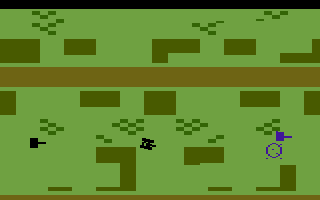
Q: Did you prefer programming for the Intellivision or the Atari VCS?
Hal Finney: The Intellivision was much easier, but in a way there was more of a sense of satisfaction with the Atari since it was so difficult just to get a coherent picture on the screen. Everything in a VCS program was timed to synchronize with the TV screen - every scan line, every horizontal and vertical retrace. It was really hand-crafted Assembler. With the Intellivision we had interrupts to do the timing, and Dave had created the Exec, which was a system control and library ROM that was in all the units and hid a lot of the gory details.
Q: Iíve read the early name for Armor Ambush was Tank Battle. Is this correct? Do you recall if any of your other games had tentative titles? Did you have any input with naming your games (artwork, manuals, etc.)?
Hal Finney: I don't remember many details about the names, sorry.
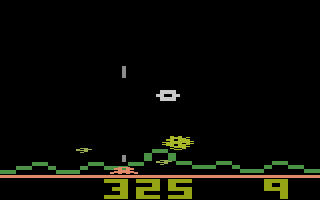
Q: Astroblast may very well be the only VCS game that allows for both either a joystick or paddle for control. Why was the compatibility for both included? Dark Cavern also has a unique control setup, allowing the player to use either the left or right joystick. Were these your ideas?
Hal Finney: Man, all those VCS games blend together for me. I can't even remember which ones I did. For a while I was just cranking them out, a few weeks for each one. I don't remember any details about Astroblast or why we did it that way.
I always thought Dark Cavern was one of my more successful porting efforts. There is the usual Atari flashing when we get too many sprites on a scan line but it wasn't too bad. In fact I think I may have even adjusted the "AI" (such as it was!) of the bad guys to try to avoid that - they would turn away if they were going to get on the same line as others. We couldn't control the player's motion of course so it wasn't prevented altogether.
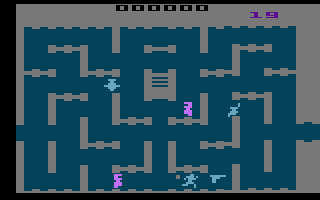 The game played very smoothly on the 2600, and the Atari controller was really better than the Intellivision wheel for getting around corners. I tuned the programming for the 2600 controller, which had only 4 directions (Ed.: Actually 8 directions)
compared to 16 (?) for the wheel. If you were in a north-south corridor and pressed right or left, and you were almost to an intersection, I'd keep you going N/S until you got there and then switch to the direction you had pushed. Sounds obvious, but not every game did that kind of thing. The result is that it's got a very 'slick' feel and you can slide around corners easily, quickly shoot and duck back, that kind of thing. I enjoyed playing it quite a bit while doing the
programming.
The game played very smoothly on the 2600, and the Atari controller was really better than the Intellivision wheel for getting around corners. I tuned the programming for the 2600 controller, which had only 4 directions (Ed.: Actually 8 directions)
compared to 16 (?) for the wheel. If you were in a north-south corridor and pressed right or left, and you were almost to an intersection, I'd keep you going N/S until you got there and then switch to the direction you had pushed. Sounds obvious, but not every game did that kind of thing. The result is that it's got a very 'slick' feel and you can slide around corners easily, quickly shoot and duck back, that kind of thing. I enjoyed playing it quite a bit while doing the
programming.
Q: Besides Star Strike and Adventures of TRON, did you have Easter eggs in any of your other games?
Hal Finney: I remember that in Star Strike, I had a few bytes free in the cartridge so I put in a little loop that just incremented every location in the video RAM, producing a strange-looking and dramatic effect on the screen.
I don't remember any others; at the time we were so pressed for space, saving every byte we could for game graphics, that there was little room for the program logic and text necessary for Easter eggs.
Q: Do you remember any glitches/bugs that gave you trouble during development of any title, or ones that slipped by QA and were never solved (through a software revision)?
Hal Finney: No, sorry, I can't remember anything like that.
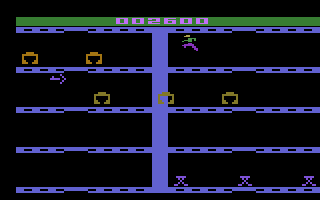
Q: Any games that you worked on and never finished, or any ideas that you wanted to implement with any of your released games but couldnít (due to time or memory restrictions)? Do you recall any titles that others worked on that never got released?
Hal Finney: Well, there were enormous efforts made for the Keyboard Component, which never really got released. I worked for months on the Jack LaLanne's Physical Conditioning exercise program. I actually got to meet Jack, we had him come into the sound studio and record some motivational
tracks, plus we hired an incredibly talented musician, Robert Randall, who wrote a bunch of original musical compositions that really pushed the Intellivision sound chip to its limits. Dave Rolfe had to write a new sound programming language to incorporate Randall's creative ideas.
We had all this software to sync between the Intellivision video and the audio coming from the tape drive, pulling program code off the tape as well. I remember spending weeks trying to lip-sync "Mimi", the graphic character for the Conversational French language program, to the recorded French conversations on the tape.
Anyway, it was a huge project with some amazing creative inputs, but as far as I know it has all been lost.
Q: Did you stay at APh until the crash? Did you pursue game programming beyond that point (and if not, what prompted you not to?)
Hal Finney: Yes, I stayed at APh for quite a while. I had always done other things in addition to games. I just did the two Intellivision games, and then cranked out half a dozen VCS games in a few months, and all that work on the Keyboard Component. But I also did a couple of cash registers, a spectrometer for Bausch and Lomb, and some fancy camera control software for a Hollywood special effects house. I never really thought of myself as primarily a games programmer. I was more of a general purpose Assembly language developer.
Q: Are you currently still at Network Associates?
Hal Finney: Yes, I work on crypto software now. I got started working on the freeware PGP encryption program about ten years ago, working with the author, Phil Zimmermann. When he started PGP, Inc. in 1996, he hired me. Then the company was acquired a couple of years later by Network Associates, and I have been with them ever since, working on PGP and its follow-on software.
Q: What are some of your personal favorite games (for any platform)? What are your thoughts on the current state of gaming?
Hal Finney: Actually I don't play games much! My two kids are now 18 and 20 and they have always played a lot of games over the years. They were real Nintendo fans when they were young but my son now also has a PS2. When I would play games with them, I liked the Zelda and Mario games. Mostly I still love programming and I would rather do that in my spare time than play games.
TV Powww! and WPIX Channel 11 TV Pixxx game show footage and commercial featuring Channel F and Intellivision games:
Sadly, Hal passed away in 2014. My condolences to his family.
| GAME | SYSTEM | COMPANY | STATUS |
| Adventures of TRON | Atari VCS/2600 | APh Tech. / M Network | released |
| Armor Ambush | Atari VCS/2600 | APh Tech. / M Network | released |
| Astroblast | Atari VCS/2600 | APh Tech. / M Network | released |
| Dark Cavern | Atari VCS/2600 | APh Tech. / M Network | released |
| Space Attack | Atari VCS/2600 | APh Tech. / M Network | released |
| Space Battle | Intellivision | APh Tech. / Mattel | released |
| Star Strike | Intellivision | APh Tech. / Mattel | released |
| Conversational French | Intellivision ECS | APh Tech. / Mattel | prototype |
| Jack LaLanne's Physical Conditioning | Intellivision ECS | APh Tech. / Mattel | prototype |